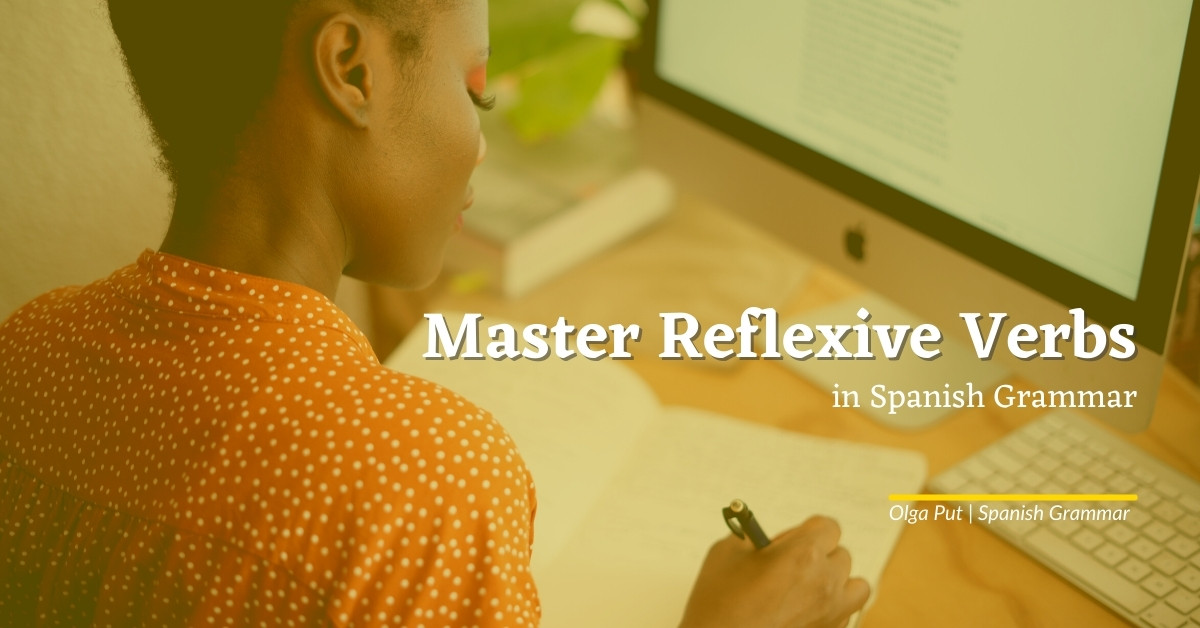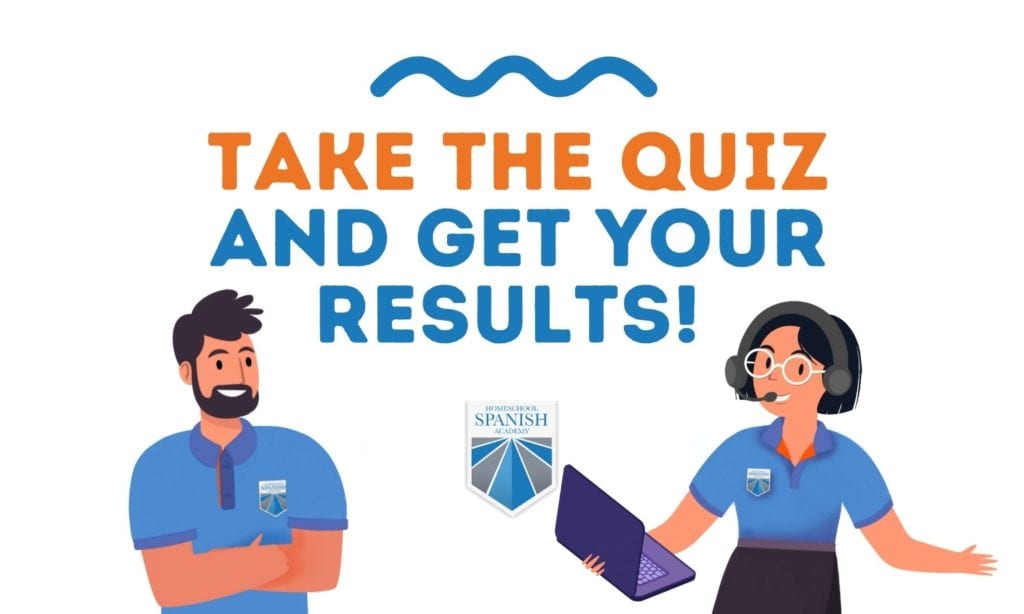
Master Reflexive Verbs in Spanish Grammar
Reflexive verbs are like crossing a threshold in a hero’s journey. There’s no way back, you set off on a mission after some possible initial resistance and doubts.
Reflexive verbs in Spanish are an important topic and in this guide, you get all you need to master them.
Sections include:
- How to use them
- When to use them
- How to conjugate them
- How to form them
- How to distinguish them from other verbs that look reflexive but are not.
This guide also covers different types of reflexive verbs and you’ll be able to check your understanding in a quiz at the bottom!
After you complete this guide, you’ll see that mastering Spanish reflexive verbs is easier than you thought!

Download the Reflexive Verbs in Spanish Grammar Cheat Sheet!
Type in your name and email below! We’ll immediately send the Reflexive Verbs in Spanish Grammar cheat sheet to your inbox!
What Are Reflexive Verbs in Spanish?
Reflexive verbs talk about things you do to and for yourself. This means that the subject of the sentence (the person performing the action) is the same as the object of the sentence (the person receiving the action).
See this example:
Me levanto, me ducho y me peino.
I get up, I get a shower and I comb myself.
In the sentence above, you have three reflexive verbs:
levantarse (me levanto) – to get up
ducharse (me ducho) – to have a shower
peinarse (me peino) – to comb one’s hair
All of them refer to actions performed and received by the same person. You get up yourself and you’re the one that is up. You are the one that washes yourself and you’re the clean one. You take the comb and comb your own hair.
Many verbs that refer to a daily routine are reflexive verbs. But we also use reflexive verbs to talk about personal care or change of status (more on that below).
How Do You Form Reflexive Verbs?
To get a reflexive verb, you’ll need two things:
- main verb
- reflexive pronoun
Reflexive Verbs and Reflexive Pronouns
Did you notice that all the three verbs from the example end in -se? This is a reflexive pronoun, like a reflexive ending that can transform a non-reflexive verb into a reflexive one.
For example, the verb levantar can mean “to lift” or “to wake (somebody) up.” When you add -se, levantarse means “to get oneself up.”
In Spanish, reflexive verbs always appear with personal, self-referential pronouns. Six reflexive pronouns exist, according to the grammatical person:
| Subject Pronoun | Reflexive Pronoun |
| yo | me |
| tú | te |
| él, ella, usted | se |
| nosotros, nosotras | nos |
| ustedes | se |
| ellos, ellas | se |
Sometimes, you may translate the reflexive pronoun into “self.” For example, me peino means “I comb myself,” but not always! I’ll tell you more about this mystery later on.
Before I continue, let’s look at a complete conjugation of one reflexive verb—peinarse—in the present simple tense.
Notice how the reflexive pronoun changes with the conjugated verb ending.
| Subject Pronoun | Reflexive Pronoun & Verb |
| yo | me peino |
| tú | te peinas |
| él, ella, usted | se peina |
| nosotros | nos peinamos |
| ustedes | se peinan |
| ellos, ellas | se peinan |
Me peino y me voy.
I comb my hair and leave.
Ana se peina siempre igual.
Ana always combs her hair the same.

Just remember, that to conjugate a reflexive verb you need to conjugate the main verb according to the group in which it belongs (-ar verbs, -er verbs, or -ir verbs). If you’d like a refresher on this topic, check out the following articles:
- A Semi-Comprehensive List of -AR Verbs in Spanish
- A Semi-Comprehensive List of -ER Verbs in Spanish
- Ir Conjugation: A Spanish Verb Lesson for Inspired Beginners
Reflexive Verbs Placement
Look at this is the formula for the reflexive verbs use in a sentence:
(Subject) + reflexive pronoun + conjugated main verb
(Yo) me levanto a las siete de la mañana.
I get up at seven in the morning.
As you can see the reflexive pronoun appears here before the conjugated verb. This is the formula you will follow in most types of sentences. However, there are some situations when the word order will be different.
1. Imperative Form
When giving commands, you attach the reflexive pronoun to the end of the verb. However, if the command is in negative form, you will place the reflexive pronoun before the verb.
Levántate, por favor.
Get up, please.
¡No te peines así!
Don’t comb yourself like this!
2. Infinitive
If the reflexive verb is in the infinitive form, you have two options to choose from. You can put the reflexive pronoun at the end of the infinitive, or you can put it before the conjugated verb. Totally up to you.
Por favor, ¿puedes peinarte?
Por favor, ¿te puedes peinar?
Could you comb your hair, please?
3. Gerund (the “-ing” form)
With the gerund forms, you have two options as well. You can put the reflexive pronoun before the conjugated estar (to be), or you can include it at the end of the reflexive verb in the gerund form. If you choose the latter, don’t forget to add the accent mark.
Miguel está bañándose.
Miguel se está bañando.
Miguel is taking a bath.

Use of Reflexive Verbs in Spanish
Let’s have a closer look now at when and how you can use the reflexive verbs. It’ll be easier if we split them into different categories.
1. Verbs That Are Always Reflexive
There are some verbs that exist only with the reflexive pronoun attached to them. They rarely translate to “self,” and you simply need to remember that they’re reflexive.
It might not sound very logical at the beginning, but you do get used to it with time!
Common Reflexive Verbs Chart
| Spanish | English |
| aburrirse | To get bored |
| acordarse | to remember |
| atreverse | to dare |
| burlarse | to make fun of |
| caerse | to fall |
| casarse | to get married |
| confundirse | To get confused |
| divertirse | to have fun |
| enterarse | to find out |
| imaginarse | to imagine |
| portarse | to behave |
| preocuparse | to worry |
| quedarse | to stay |
| reírse | to laugh |
Imagínate el futuro.
Imagine the future.
Yo nunca me burlo de ti.
I never make fun of you.
Nos portamos bien y nos dieron un premio.
We behaved well and they gave us an award.
No te rías de mí.
Do not laugh at me.
Me acuerdo de cuando éramos niños.
I remember when we were children.
Se atrevió a contestarle.
He dared to answer him.
¡Se cayó solo! ¡Te lo juro!
It fell by itself! I swear!
Mis papás se casaron en la playa.
My parents got married on the beach.
No te preocupes, lo solucionaremos.
Don’t worry, we’ll fix it.
Ahora me estoy quedando con mis amigos.
Now, I’m staying with my friends.
Te vas a divertir, te lo prometo.
You’re going to have fun, I promise you.
Nunca me entero de nada.
I never find out about anything.
Emotional Verbs
What about emotions? These verbs are always reflexive and express emotion.
| Spanish | English |
| Alegrarse | To be happy |
| Asustarse | To get scared |
| Cansarse | To get tired |
| Divertirse | To have fun |
Ella se alegra de ver a su hermano.
She is happy to see her brother.
Nosotros nos asustamos fácilmente.
We get scared easily.
Ustedes se cansan de correr.
You get tired of running.
Ellos se divierten juntos.
They have fun together.
2. Verbs That Are Sometimes Reflexive
There are also numerous verbs that can be both reflexive and non-reflexive—but watch out! The meaning often changes, similar to levantar vs. levantarse.
bañar (to bath) – bañarse (to take a bath)
¿Puedes bañar a tu hermanito?
Can you bathe your little brother?
¿Puedes bañarte?
Can you take a bath?
despertar (to wake up someone) – despertarse (to wake up)
In the following examples, the first sentence is not reflexive although it appears to be. It’s not reflexive because the subject (un ruído) is different from the object (me). Me is an indirect pronoun here and not reflexive.
Me despertó un gran ruído.
A great noise woke me up.
Me desperté de repente y me acordé que no había pagado los impuestos.
I woke up suddenly and realized that I had not paid my taxes.
dormir (to sleep) – dormirse (to fall asleep)
Mi perro duerme toda la noche.
My dog sleeps through the night.
Me duermo a las 9 pm.
I fell asleep at 9 pm.

molestar (to annoy) – molestarse (to get bothered)
Me molesta la gente maleducada.
Rude people annoy me.
No se moleste señora, yo lo hago.
Don’t bother ma’am. I’ll do it.
Here are some other examples:
| Non-reflexive verb | Reflexive verb |
| admirar – to admire | admirarse – to be amazed |
| aprender – to learn | aprenderse – to memorize |
| clavar – to hammer | clavarse – to fall for somebody |
| colar – to leak | colarse – to sneak in |
| confiar – to trust | confiarse – to be overconfident |
| conformar – to form | conformarse – to settle for |
| creer – to believe | creerse – to believe oneself |
| despedir – to fire | despedirse – to say goodbye |
| fijar – to set | fijarse – to watch, to notice |
| ir – to go | irse – to leave |
| llenar – to fill | llenarse – to be full |
| llevar – to carry, to take | llevarse – to get along |
| negar – to deny | negarse – to refuse |
| ocurrir – to happen | ocurrirse – to come to mind |
| parecer – to seem | parecerse – to look alike |
| perder – to lose | perderse – to get lost |
| poner – to put | ponerse – to put on |
| preguntar – to ask | preguntarse – to wonder |
| probar – to try, to taste | probarse – to try on |
| rendir – to perform | rendirse – to surrender, to give up |
| sumar – to add | sumarse – to join in |
| volver – to come back | volverse – to become |
There are some verbs that don’t change their meaning when you add the reflexive pronoun. You just emphasize that the action is done to oneself and not to someone else. Quite often you also add a uno mismo (to oneself), to emphasize the meaning even more.
Hablarse – to talk to oneself
Mirarse – to look at oneself
Amarse – to love oneself.
A veces me hablo a mí misma.
Sometimes I talk to myself.
Me miro en el espejo y sonrío.
I look at myself in the mirror and smile.
Es importante amarse a uno mismo.
It’s important to love yourself.
3. Tricky Reflexive Verbs Using Se Intensivo
There is another use of the reflexive pronoun se that can be tricky to understand. It’s called se intensivo (intensive “se”) or se delimitador (delimiting “se”) in Spanish. It’s used to indicate totality or culmination with the verbs that talk about consumption, perception, or knowledge.
In spoken Spanish, you will often hear verbs comer, beber, tomar, and fumar using the se intensivo when referring to a specific quantity consumed.
Andrés se comió una pizza.
Andres ate a pizza.
Me sé todas las capitales de Europa.
I know all the capitals of Europe.
Se bebió todo el jugo de un solo trago.
He drank the whole juice in one gulp.
Se fumó todo el paquete.
She smoked the whole package.
Pedro se gastó todo el sueldo en una semana.
Pedro spent all his salary in one week.

4. Generic “You” and Passive Sentences
When you talk about an action but you don’t want to reveal or do not know the person that performs it you can use the reflexive structure in third person singular or plural. You can translate it into impersonal “one” in English.
Let’s see some examples:
No se puede vivir en un país así. ¡Demasiada corrupción!
You (One) cannot live in such a country. Too much corruption!
Se sabe que ella no es una buena persona.
It’s known that she is not a good person.
Se venden casas en esta zona.
Houses are for sale in this area.
Reflexive Verbs vs Reciprocal Verbs
These two types of verbs are easily confused. They both use reflexive pronouns. However, they work in a different way.
Reciprocal verbs are actions that two or more people do to each other. We use them with reciprocal pronouns that are always plural. It means you will only use these plural subjects:
- nosotros (we)
- ustedes (plural you)
- ellos, ellas (they)
María y Juan se besaron en el altar por primera vez.
Maria and Juan kissed each other at the altar for the first time.
Nos abrazamos con cariño.
We hugged each other lovingly.
Reflexive verbs work with both singular and plural forms and the subject or subjects perform actions on themselves, not on each other.
Me veo en el espejo, y veo que me parezco a ti, mamá.
I see myself in the mirror and I see that I look like you, mom.
Nos miramos en el espejo y nos maquillamos.
We looked in the mirror and put on make-up.
As you can see, there is some ambiguity if you lack the context. Therefore, you can always add el uno al otro (to each other) to the reciprocal verbs to make things clear.
Nos miramos el uno al otro y sonreímos.
We look at each other and smile.
Se ayudan el uno al otro.
They help each other.
Wrapping Up
I can’t deny that it’s a huge topic and a challenging one both for new and advanced Spanish learners. However, knowing the basic rules will help you enormously and will make further practice easier.
Here are the most important things you need to remember about reflexive verbs in Spanish:
- They express action performed by a subject on oneself.
- Reflexive verbs always work with a reflexive pronoun that cannot be left out.
- The verb form and the pronoun conjugate according to the grammatical person.
- Their position in a sentence depends on the form of the verb
Test Your Knowledge With This Multiple Choice Quiz

See for yourself how much you’ve learned about the reflexive verbs in Spanish!
In this multiple-choice quiz there’s only one correct answer for each question.
1. Yo siempre ______________ temprano, pero mis hijos ______________ tardísimo. (levantarse)
2. Paco ______________ por la tarde, cuando viene del trabajo. (ducharse)
3. Ellos ______________ las manos antes de comer y los dientes después de comer. (lavarse)
4. Los españoles ______________ poco. (divorciarse).
5. Todos los veranos (nosotros) ______________ en las piscinas municipales. (bañarse)
6. ¿Qué te pasa? ¿No ______________ bien? (encontrarse)
7. What’s the correct word order:
8. Which is the correct translation for: “Don’t give up”?
9. Which is the correct translation for: “I can fall asleep in less than one minute”?
10. Which sentence is correct:



Practice Your Skills With a Native Speaker!
Reflexive verbs in Spanish are a topic that needs hours of practice. You might have understood everything now, but you’ll need to use Spanish reflexive verbs many times before their use becomes automatic. Sign up for a free class with one of our friendly and professional, native Spanish-speaking teachers from Guatemala to practice all the reflexive verbs you learned today.
I know that sometimes it’s frustrating to have to spend many hours perfecting new grammar structures but just imagine all the benefits that knowing Spanish perfectly can bring you. You could for example ask for a salary raise. Yes, that’s true. According to The Economist, one can earn anywhere from $50,000 to $125,000 extra just by knowing a foreign language alone.
¡No te rindas! ¡Sigue esforzándote!
Don’t give up. Keep working!

Ready to learn more Spanish grammar? Check these out!
- Master All the Forms of Ser in Spanish: Your Ultimate Grammar Guide
- 20 Most Common Subjunctive Triggers in Spanish
- 23 Common Spanish Prepositions You Can Use Today
- 25 Common Subjunctive Phrases in Spanish Conversation
- What Is an Infinitive in Spanish?
- A Complete Guide to Imperfect Conjugation for Beginners
- How to Talk About the Temperature in Spanish: Fahrenheit, Celcius, and Descriptions
- A Complete Guide to Preterite Conjugation for Beginners
- Familial Bonds: Expressing ‘Sister-in-Law’ in Spanish and Family Vocabulary - May 2, 2024
- 10 Homeschooling Styles You Need to Explore in 2023 - March 14, 2024
- Home Sweet Classroom: Creating Engaging Spanish Lessons at Home - October 13, 2023




